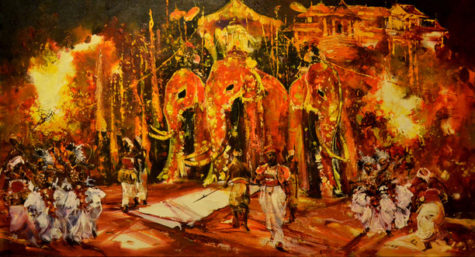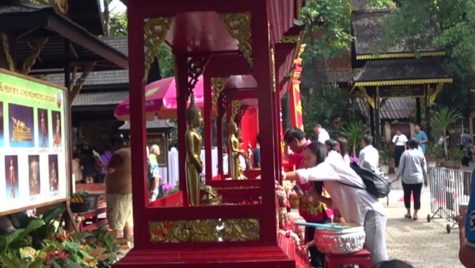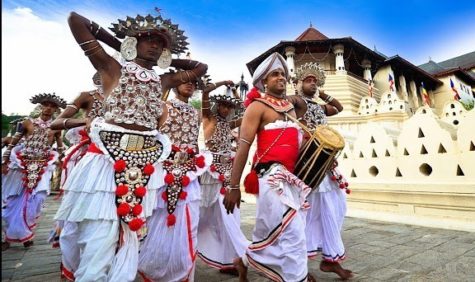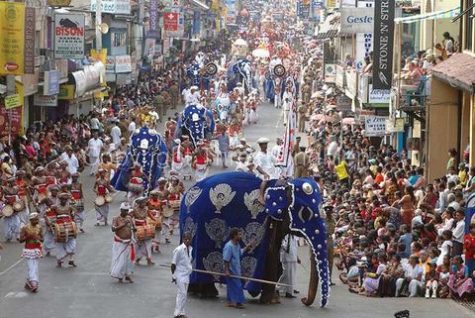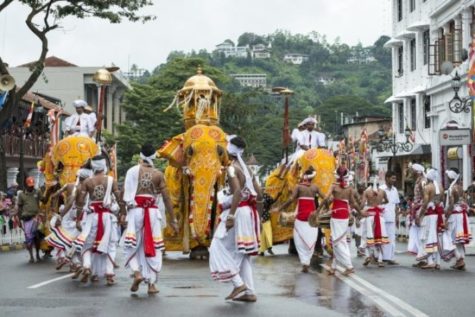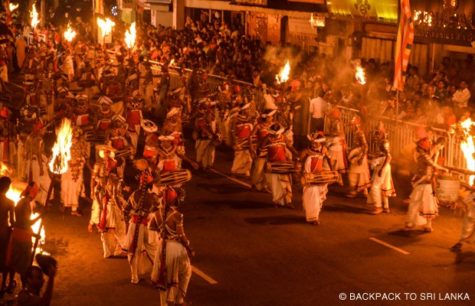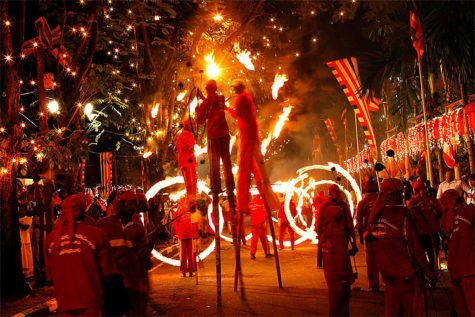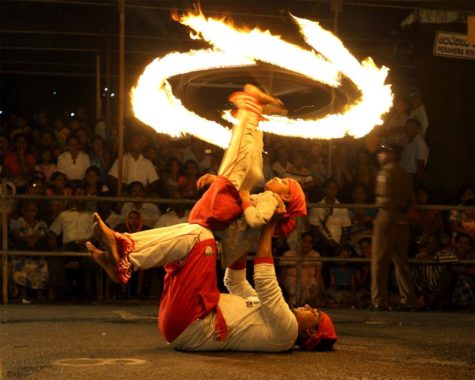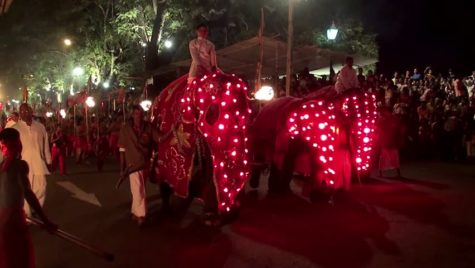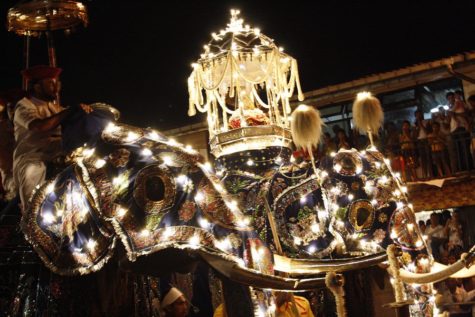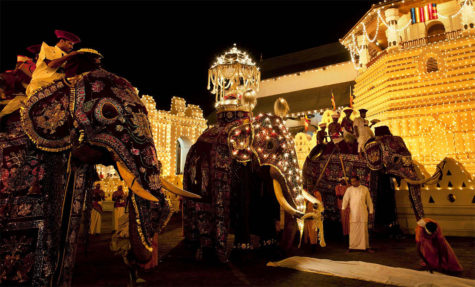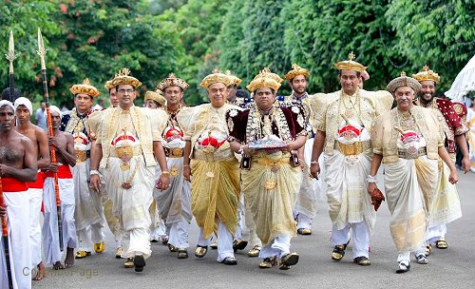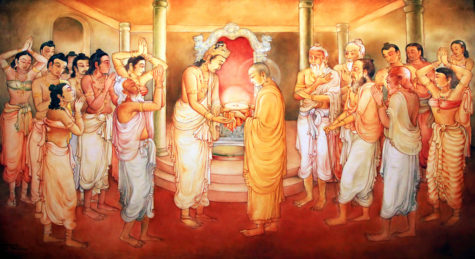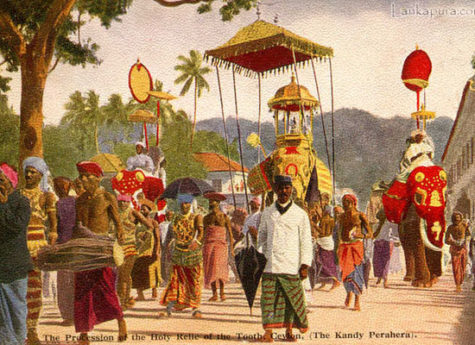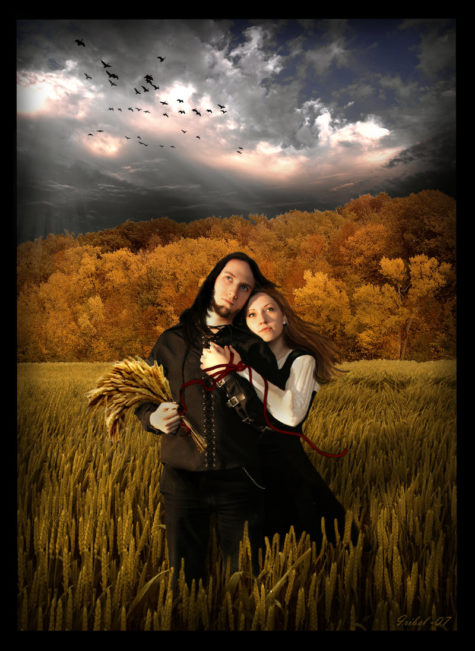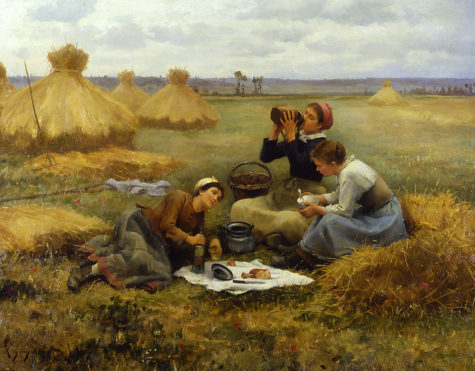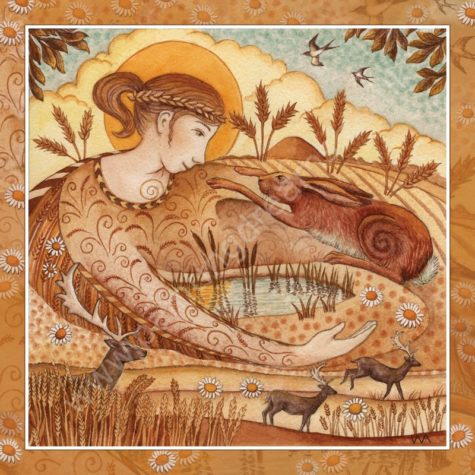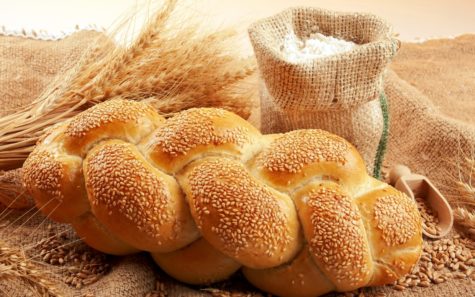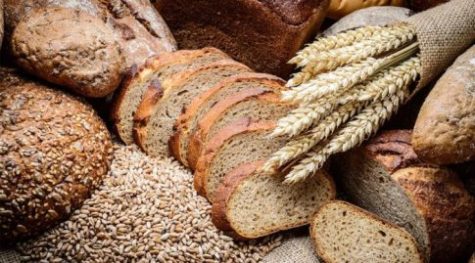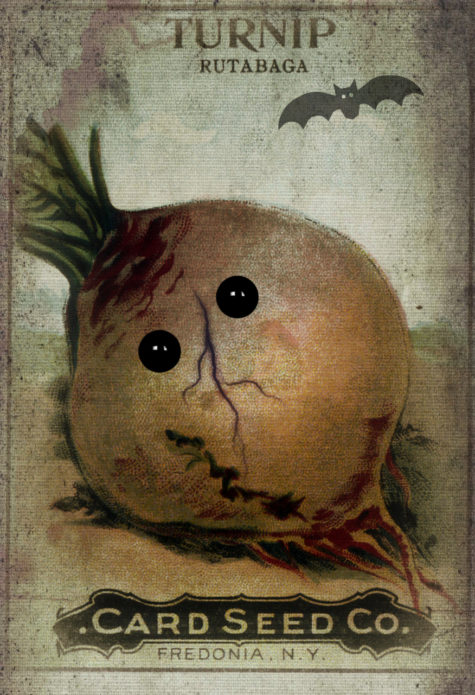The Festival of the Tooth – An extended and lavish holiday which commemorates a holy relic of Buddha, his eye tooth.
Kandy is a beautiful city in Sri Lanka. On a small hill is a great temple which was especially built to house a relic of the Buddha – his tooth. The tooth can never be seen, as it is kept deep inside may caskets. But once a year in August, on the night of the full moon, there is a special procession for it. But other festivities occur on ten days leading to that final day.
The dates of the festival vary from year to year. In 2017, the festival runs from July 29 thru August 8th. The Festival begins with the cutting of a sanctified young jack tree. Branches of the tree are then planted near the shrines of the four guardian gods Natha (a Buddhist savior), Vishnu (for safeguarding Buddhism in Sri Lanka), Kataragama (protector of the south) and the goddess Pattini (goddess of health and fertility). Traditionally, this was a ritual performed to ask the gods for blessings on the King and the people.
For the next five nights, festive dancing and drumming are held outside each of the temples. On the sixth night of the festival, processions begin from each shrine and parade toward the Temple of the Tooth. The processions get longer and more magnificent for the next three nights.
The highlight is on the last night of the processions: an enormous elephant carries a gold casket containing a replica of the Tooth Relic as the drummers and dancers enthrall the crowd along the route. The drummers and dancers themselves are followed by elephants and other groups of musicians, dancers and flag bearers.
After nights of processions, a water cutting ceremony brings the festival to an end at dawn, when priests representing each of the four temples walk into the Mahaweli River, “cut” a circle in the water with a sword and fill pitchers with water from within the circle. The water is kept till the next year’s Esala Perahera, when the pitcher will be freshly filled again.
The next day, Kandyan chieftains in ancient regalia, march to the Presidential mansion in Kandy, following royal tradition, to report to the Head of State, the successful completion of the annual event.
The story behind the tooth is as follows:
It was believed that if the Bodhi Tree that came into contact with the Buddha had the power to bring rains, then the parts of His own body had much greater power to invite rains. With this in mind, the sacred tooth relic was brought all the way from Kalinga in India to the island of Sri Lanka in the fourth century AD. At the time, the sacred tooth relic was brought to Sri Lanka, the king was Sri Megha varna. His name itself meant ‘the Resplendent one whose complexion is that of the Rain-cloud’.
The time when the sacred tooth was brought to Sri Lanka was around six centuries after the sapling of the sacred Bodhi Tree was brought into the island country. However, very soon, the popularity of the sacred tooth surpassed that of the Bodhi Tree. The simple reason for this was that it could be moved any number of times from one place to another, very unlike the Bodhi Tree itself. Also, the possesion of the tooth relic soon became a matter of power and claim to rule the land. The king who had possession of the tooth relic had the authority to rule the land and, wars were fought to keep the relic from falling into hostile hands.
This is amply manifested in the attempt made by the kings when the Europeans enhanced their power in the island country. King Senarath quickly transported the relic a little distance away from Kandy when the Portuguese came to close for his comfort. Later, the significance of the tooth relic became known to the Europeans themselves. They wasted no time and made it their primary goal to get hold of the precious relic. The British succeeded in 1818, and the people themselves gave up all efforts to prevent the former from ruling them, all because the British possessed the tooth relic.
Historically, a number of festivals were celebrated to honor the sacred tooth relic right from time it came to Sri Lanka. Initially, processions or peraheras were taken out for the tooth relic alone. However, later, the festival was incorporated with another festival meant to appease the rain god, the Esala peraheras. At this time, a Kandyan king, Kirti Shri Rajasinghe was in power and he made it possible for the common people to worship the relic by announcing that it would be taken out in a procession for the masses to see and offer their prayers. Before this, the tooth relic was the property of the king and the common people were not allowed to worship it.
Source: Wikipedia and My Odyssey Tours
Lughnasadh (pronounced “LOO-nahs-ah”) aka Lammas, is one of the Greater Wiccan Sabbats and is usually celebrated on August 1st or 2nd, although occasionally on July 31st. The Celtic festival held in honor of the Sun God Lugh (pronounced “Loo”) is traditionally held on August 7th. Some Pagans celebrate this holiday on the first Full Moon in Leo.
Other names for this Sabbat include the First Harvest Festival, the Sabbat of First Fruits, August Eve, Lammastide, Harvest Home, Ceresalia (Ancient Roman in honor of the Grain Goddess Ceres), Feast of Bread, Sabbat of First Fruits, Festival of Green Corn (Native American), Feast of Cardenas, Cornucopia (Strega), Thingtide and Elembiuos. Lughnassadh is named for the Irish Sun God Lugh (pronounced Loo), and variant spellings for the holiday are Lughnassadh, Lughnasad, Lughnassad, Lughnasa or Lunasa. The most commonly used name for this Sabbat is Lammas, an Anglo-Saxon word meaning “loaf-mass”.
At Lammas, the hot days of August are upon us, much of the earth is dry and parched, but we still know that the bright reds and yellows of the harvest season are just around the corner. Apples are beginning to ripen in the trees, our summer vegetables have been picked, corn is tall and green, waiting for us to come gather the bounty of the crop fields. Now is the time to begin reaping what we have sown, and gathering up the first harvests of grain, wheat, oats, and more.
It’s the dog days of summer, the gardens are full of goodies, the fields are full of grain, and the harvest is approaching. Take a moment to relax in the heat, and reflect on the upcoming abundance of the fall months. At Lammas, sometimes called Lughnasadh, it’s time to begin reaping what we have sown throughout the past few months, and recognize that the bright summer days will soon come to an end.
Depending on your individual spiritual path, there are many different ways you can celebrate Lammas, but typically the focus is on either the early harvest aspect, or the celebration of the Celtic god Lugh. It’s the season when the first grains are ready to be harvested and threshed, when the apples and grapes are ripe for the plucking, and we’re grateful for the food we have on our tables.
Lammas is a time of excitement and magic. The natural world is thriving around us, and yet the knowlege that everything will soon die looms in the background. This is a good time to work some magic around the hearth and home.
This is also a time when the God mysteriously begins to weaken as the Sun rises farther in the South, each day grows shorter and the nights grow longer. The Goddess watches in sorrow as She realizes that the God is dying, and yet lives on inside Her as Her child. It is in the Celtic tradition that the Goddess, in her guise as the Queen of Abundance, is honored as the new mother who has given birth to the bounty; and the God is honored as the God of Prosperity.
Deities associated with Lughnassadh are all Grain and Agriculture Deities, Sun Gods, Mother Goddesses and Father Gods. Particular emphasis is placed on Lugh, Demeter, Ceres, the Corn Mother and John Barleycorn (the personification of malt liquor).
Activities appropriate for this time of the year are:
- Baking bread – especially bread baked in the form of a God-figure or Sun Wheel
- Wheat weaving – such as the making of Corn Dollies, or other God and Goddess symbols which may be used both as a fertility amulet and an altar centerpiece.
- Sand candles can be made to honor the Goddess and God of the sea.
- You may want to string Indian corn on black thread to make a necklace,
- Bake corn bread sticks shaped like little ears of corn
Other actions include the gathering of first fruits and the study of Astrology. Some Pagans symbolically throw pieces of bread into a fire during the Lammas ritual. Spellwork for prosperity, abundance and good fortune are especially appropriate now, as well as spells for connectedness, career, health and financial gain.
The celebration of Lammas is a pause to relax and open yourself to the change of the Season so that you may be one with its energies and accomplish what is intended. Visits to fields, orchards, lakes and wells are also traditional. It is considered taboo not to share your food with others.
Correspondences for Lughnasadh:
- Colors: red, orange, gold, and yellow. Also green, citrine and gray.
- Candles: golden yellow, orange, green, or light brown.
- Stones: yellow diamonds, aventurine, sardonyx, peridot and citrine.
- Animals: roosters and calves.
- Mythical creatures: phoenix, griffins, basilisks, centaurs and speaking skulls.
- Plants: corn, rice, wheat, rye, ginseng, ash tree.
- Herbs: vervain, acacia flowers, aloes, cornstalks, cyclamen, fenugreek, frankincense, heather, hollyhock, myrtle, oak leaves, sunflower, and wheat.
- Incense: aloes, rose, rose hips, rosemary, chamomile, passionflower, frankincense, and sandalwood.
Traditional Pagan Foods for the Lughnassadh Festival include homemade breads (wheat, oat and especially cornbread), corn, potatoes, berry pies, barley cakes, nuts, wild berries, apples, rice, roasted lamb, acorns, crab apples, summer squash, turnips, oats, all grains and all First Harvest foods. Traditional drinks are elderberry wine, ale and meadowsweet tea.
It is also appropriate to plant the seeds from the fruit consumed in ritual. If the seeds sprout, grow the plant with love and as a symbol of your connection to the Divine. A cake is sometimes baked, and cider is used in place of wine.
Key actions associated with Lammas are receiving and harvesting, honoring the Parent Deities, honoring the Sun Gods and Goddesses, as well as celebration of the First Harvest.
From: PaganWiccan and other sources,
Lammas and Lughnasadh are ancient Pagan festivals celebrated in many parts of the world. Typically falling on the first day of August, these festivals celebrate the fruits of the first harvest of the year with a focus upon gratitude and blessings for abundance. The names Lammas and Lughnasadh are often used interchangeably which can create some confusion but the following will help to clear things up.
Lughnasadh, which is pronounced LOO-nah-sah, traces its roots far back into Irish history. In Celtic mythology the god Lugh is said to have held a funeral feast in honor of his foster mother Tailtiu, who died after clearing the plains of Ireland for the purpose of agriculture.
The festival of Lughnasadh became a day based upon this Celtic myth and historically it was a day of contests, games, handfasting or marriage, and seeking lodging for the long winter months. It was also one of the four main festivals of the Irish medieval calendar signaling the height of summer and the approach of autumn. The word Lughnasadh means “marriage of Lugh” which again ties in with Celtic mythology, for the god Lugh was seen as married to the land, or earth, and sacrificed to the earth. This is symbolic of crops being planted and then “sacrificed” in harvest.
Many modern-day Pagans celebrate the festival of Lughnasadh in a variety of ways, depending upon the Pagan tradition that they follow and their personal preferences. In Wicca, Lughnasadh is viewed as one of the eight sabbats that make up the Wheel of the Year. In Dianic Wicca often focus primarily upon the Goddess aspect in the form of the Goddess of plenty, Kore and Ceres or Habondia.
Celtic Reconstructionists base the celebrations of Lughnasadh largely upon historical research of the polytheist beliefs of the ancient Celts and typically celebrate it on the day of the full moon that falls closest to the festival. They often recognize the day by giving thanks and asking the deities to grant them a bountiful harvest. Many Celtic Reconstructionists will also honor the goddess Tailtiu on this day.
- More about Lughnasadh can be found here: Lughnasadh aka Lammas
Lammas was the name used in medieval England for the Christian holiday that celebrated early harvest. An Anglo-Saxon word, Lammas is thought to be a combination of the words loaf mass, the reason being that in medieval times it was typical for loaves of bread baked from the grains of the first harvest to be blessed during a church ceremony at that time.
However, Lammas was originally a Pagan harvest festival that, like Lughnasadh was one of gratitude and celebrating the first grains of harvest even though, in some parts of the world, it was incorporated into the Christian church.
- More about Lammas can be found here: Lammas – A Feast of Bread
Today Lammas is viewed primarily as a Pagan festival and many modern-day Pagans view Lammas and Lughnasadh as the same thing although the history behind each of the names is slightly different.
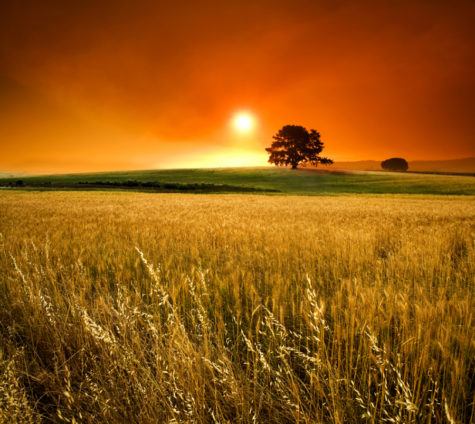
In many cultures around the world, staple crops such as corn and rice are believed to embody a spiritual essence.
In European cultures, a corn doll was often used to represent the spirit of the harvested crops. However, Europe didn’t have a monopoly on this at all. In South American countries, some tribes took the largest portion of the crops — typically maize — and dressed it in clothing as an effigy.
In Peru, people honored different spirits of the crops. The Maize Mother was the zara mama, the spirit of quinoa was known as quinoa mama, and everything from the cocoa tree to the lowly potato had a life essence.
In North America, the native tribes grew corn, or maize, as a staple part of their diet. Some groups have stories of rebirth and regeneration, and a few have folktales that parallel the story of Demeter and Persephone. In the southwestern part of the United States, Native Americans still perform a ceremonial dance that honors the harvesting of the maize every fall.
It’s not uncommon to find spiritual connections to agriculture. The Malay people of Indonesia believe that rice plants — again, a staple crop — possess a soul or life force just as humans do. Harvesting is even done in a way that is seen as “painless” to the rice plants, so that it will not suffer. In some parts of the Malay Peninsula, there is a big ceremony at the beginning of each harvest, in which a complex ritual is performed that identifies the mother of the rice soul in the selected sheaf.
Folklorist Sir James Frazer makes mention in The Golden Bough of the global phenomenon of the honoring of the spirit of the grain. He says that the mere fact that underdeveloped, primitive cultures honor a “corn mother” archetype indicates that this has been going on for thousands of years. In other words, because these cultures are “unspoiled” by modern society, their worship of such an embodiment of the grain is probably very close to the original ritual and ceremony.
Article by: Patti Wigington
Lammas is very old indeed. It derives from the ancient English festival the Gule of August, which marked the beginning of the harvest, traditionally August 1.
The early English church kept this pagan dedication of the first fruits but converted it to Christian usage. The word Lammas derives from the Old English phrase hlaf-maesse, which translates to loaf mass. In early Christian times, the first loaves of the season were blessed by the Church.
Through the centuries, “loaf-mass” became corrupted in spelling and pronunciation to Lammas. On Lammas Day, loaves of bread were baked from the first-ripened grain and brought to the churches to be consecrated.
To the Celts, this was Lughnasaid, the feast of the wedding of the Sun god and the Earth goddess, and also a harvest festival. In Ireland, baskets of blueberries are still offered to a sweetheart in commemoration of the original fertility festival. In Scotland, the Lammastide fairs became famous for trial marriages that could be ended without question after a year.
“After Lammas Day, corn ripens as much by night as by day.”
In early Ireland, it was a bad idea to harvest your grain any time before Lammas – it meant that the previous year’s harvest had run out early, and that was a serious failing in agricultural communities. However, on August 1, the first sheaves of grain were cut by the farmer, and by nightfall his wife had made the first loaves of bread of the season.
Bread is the ultimate symbol of the Lammas season. After all, once the grain is harvested, it is milled and baked into bread, which is then consumed. It is the cycle of the harvest come full circle. The spirit of the grain god lives on through us in the eating of the bread. In many traditions, a loaf of special bread is baked in the shape of a man, to symbolize the god of the harvest.
You can easily make a loaf of Lammas bread by using a pre-made loaf of bread dough, found in the frozen food section in your grocery store. Certainly, you can make your own dough, but if you’re not much of a baker, this is an easy alternative. Or, if you prefer to make your own, here’s a recipe: Lammas Bread
Sources: The Fairy Party Book and Almanac.com
Bread is the ultimate symbol of the Lammas season. After all, once the grain is harvested, it is milled and baked into bread, which is then consumed. It is the cycle of the harvest come full circle. The spirit of the grain god lives on through us in the eating of the bread. In many traditions, a loaf of special bread is baked in the shape of a man, to symbolize the god of the harvest.
You can easily make a loaf of Lammas bread by using a pre-made loaf of bread dough, found in the frozen food section in your grocery store. Certainly, you can make your own dough, but if you’re not much of a baker, this is an easy alternative. If you’d like to make your own, here’s a recipe:
Ingredients:
- 2 cups whole wheat flour
- 2 cups bread flour, plus more if needed
- 1/4 cup toasted sesame seeds
- 2 tablespoons active dry yeast
- 2 1/2 teaspoons salt
- 2 cups milk, scalded
- 3 tablespoons smooth peanut butter
- 3 tablespoons honey
How to make it:
Mix all the dry ingredients in a large bowl. Add the peanut butter and the honey to the hot milk and stir to combine. Cool milk mix until it reaches 115ºF. Stir milk mix into flour mix.
Knead for 15 minutes, adding more flour if necessary to make a smooth, elastic dough. Oil the dough’s surface, then cover with plastic or a damp towel.
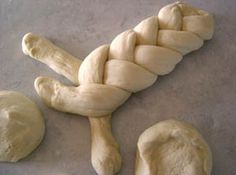 Let it rise in a warm spot until double. Punch down, then shape into 2 rectangle loaves, which could be subdivided into three equal sections and braided, or you could make one large braided wreath. Sometimes these loaves are shaped into “man” shapes, or if you’re really artistic, into a sheaf of wheat.
Let it rise in a warm spot until double. Punch down, then shape into 2 rectangle loaves, which could be subdivided into three equal sections and braided, or you could make one large braided wreath. Sometimes these loaves are shaped into “man” shapes, or if you’re really artistic, into a sheaf of wheat.
Let rise again until doubled. Bake at 375ºF until golden; it should make a hollow sound when tapped. Yield: 1 large or 2 regular-sized loaves
Source: The Fairy Party Book
August, originally called Sextilis by the Romans, was later named Augustus in honor of Augustus Caesar. Gathered harvests were celebrated in many lands during this month.
August 1st was a Celtic feast called Lunasa or Lughnassadh, meaning the celebration of harvest and new grain for bread. In Old English this became Lammas, or “Loaf Mass.” The Romans also had a harvest festival during this month, that of the Consualia when sacrifices to Consus were made. Consus was the god of the underground storehouse where the grain was kept.
They also celebrated the Opseconsiva, a harvest festival for the goddess Ops. Wine and freshly baked bread were placed on her altars. Near the end of the month they had a thanksgiving feast called the Charisteria.
At three times during August, the Romans honored the god Vulcan: on August 17 at the Portunalia; on August 27 at the Volturnalia; and again on August 23 at the Volcanalia. this last festival was held outside the city boundaries and was to ward off accidental fires, a real threat in such closely-packed and fire-prone towns. Vulcan was not the only deity honored during these festivals. The goddesses Juturna (deity of fountains) and Stata Mater (who put out fires) were invoked as a counterbalance to Vulcan’s fires – volcanoes or otherwise.
The very early Greeks had a holy day for Hecate the Dark Mother on August 13, and ten days later one for Nemesis, the goddess who balanced the scales of justice with rightful revenge and punishment. In Rome, women who had prayers answered by Diana and Hecate marched by torchlight to the temples of these goddesses. There they held a special ceremony for women only and gave thanks.
The Egyptian Blessing of the Boats is quite similar in nature to the Roman festival of the Ludi Piscatari in June during the Mead Moon. Each boat was considered to have its own personality and a need for protection and blessing. The same can apply today to cars, boats, bikes, motorcycles, and in fact to any form of transportation upon which one relies.
In India today, the Hindu people still honor the elephant-headed god Ganesha, the deity who removes obstacles and brings good luck. Flowers and dishes of rice were set before his statues. However, it is considered unlucky to look at the Moon during this festival.
Yapaquix (Sowing Month), also known as Chacra Ayapui or Capac Siquis, was celebrated by the Incas. The people of Tibet had only one major holiday this month, the Sikhim festival of the birth of Padmasambhava.
From: Moon Magick
Bread is a central feature in Lammas and Lughnasadh celebrations. Here’s a great recipe for whole grain bread:
In a large mixing bowl combine:
- 2 cups milk (warm to the touch)
- 2 packages of dry baking yeast
- 1 teaspoon salt
- 1/2 cup honey
- 1/4 cup dark brown sugar
Cover this mixture and set aside in a warm place until it has doubled (about half an hour). Add to this mixture:
- 3 tablespoons softened butter
- 2 eggs
- 1 cup of unbleached white flour
Stir until bubbly. Now mix in:
- 1/2 cup wheat germ
- 1/2 cup of rolled oats
- 2 cups stone ground wheat flour
- 2 tablespoons sesame seed
With floured hands, turn this dough out onto a floured board and gradually knead in more unbleached white flour until the dough is smooth and elastic and no longer sticks to your fingers.
Place this dough in a greased bowl, turning it so that the dough is greased. Then cover it with a clean cloth and keep it in a warm place to rise until it is doubled (about an hour).Then punch it down and divide it into two or more elongated loaves, roughly sculpted into mummiform shapes, and placed on greased cookie sheets.
Cover these and return them to a warm place until they double again. Bake the loaves in a pre-heated oven at 350 degrees for about an hour, or until they are done and sound hollow when tapped.
Today, July 25, is a Day Out of Time. This is the last day of the galactic year in the Mayan and Galactic calendar.
Here’s the math:
13 moons of 28 days = 364 days.
The extra day, the 365th day, is July 25.
This is why it is called “Day Out Of Time”
This is a special day for ritual, meditation and prayer.
Source: Souled Out
